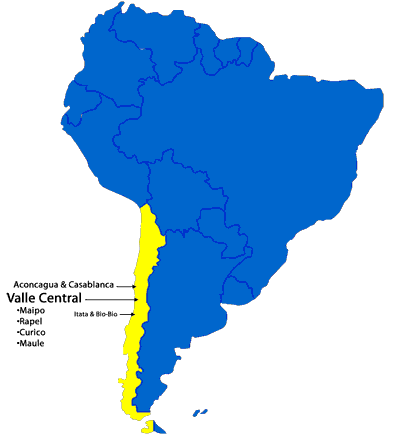
Chile
 Overview
Overview
A collection of my Essays on Chile
Located on the western most coast of South America, Chile has long been a country of isolation. With the Pacific on its left, and the Andes on its right, deserts to the north, and Antarctica to its south, Chile stood alone for generations.
This helped to create the one thing the vineyards of Chile were most famous for, the lack of the vine pest phylloxera (which has devastated most of the rest of the world sometime in the last 150 years).
Chile is experiencing globalization in the 21st century, and not only does it bring new technology, new markets and new investments, but it greatly increases the risk of phylloxera in the future.
It was once a proud boast, that all the vines of Chile were grown on their own rootstock (special hybrid rootstock are resistant to phylloxera and other problems). Now the cry is for control and increased quality, and rootstock, and much more, has been introduced to usher in a new era for Chile.
The tradition of making wine in Chile is centuries old. In the 19th century it was said that the largest wine estate was found here. Much of this wine was based on the Pais grape, which is known in California as Mission. These wines were not what modern consumers would expect, and so Chile began to change.
Just within the last decade an influx of interest, and most importantly money, has helped to modernize the vineyards and wineries of Chile. Cabernet Sauvignon and Carmenere show tremendous promise as do crisp whites like Sauvignon Blanc.
The main growing area is collectively known as The Central Valley. Here you will find the most well known wine areas. From north to south they are the valleys of Maipo, Rapel, Curico and Maule. Cab is king in the north, and the wines lighten as they move south. Maule was once known for bulk wines made from Pais, but that is in the past. Now this region is home to some of the best Cabernet in the country. Sub regions like the Conchagua Valley are home to exotic blends of Cabernet and Syrah with the near national variety of Carmenere thrown in to give the wines a local character.
Just north of the Central Valley is the Aconcagua. It is divided into the Aconcagua Valley itself and the up and coming Casablanca Valley. The Aconcagua is known for reds, while the cooler Casablanca is being developed (at great effort and cost) to produce white wines.
The area just south to the Central Valley, the Sur (Spanish for South) contains the subregion of Itata and Bio-Bio which have seen large investments of late. Expect to see much more from this area.
Copyright WineEducation.com
Do not reprint without permission